Singing a Whole New Song
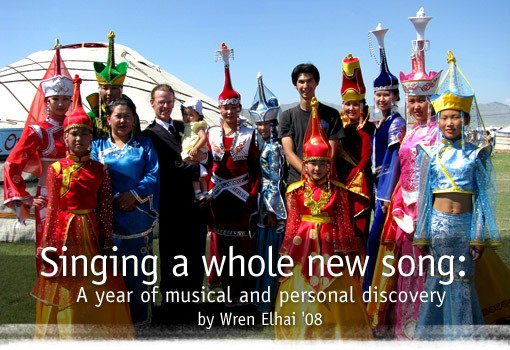

Wren Elhai '08 has been singing since childhood; he first explored vocal percussion through a cappella music. At Swarthmore he served as the musical director for Sixteen Feet, the College's all-male a cappella group. He was also a founding member of War News Radio, a student-produced weekly news program that focuses on personal accounts of the wars in Iraq and Afghanistan. The Watson Fellowship provided him with support for a full year of independent exploration and travel, much of which he chronicled on his blog. Today he is back on American soil, working at the Center for Global Development, an independent, nonprofit policy research organization that is dedicated to reducing global poverty and inequality. You can reach him at welhai@cgdev.org.
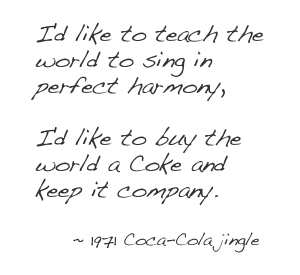
Singing in perfect harmony is all well and good. But, with due respect to the Coca Cola company, if there is one thing I learned during my year as a Thomas J. Watson Fellow, it's that we might be better off if we did a little more listening to how the world likes to sing.
The Watson fellowship supported me for a postgraduate year of independent study and travel abroad, which I used to pursue a project I called "Who Needs Instruments? Mouth music and Vocal Imitation." During the course of the year, I traveled through three continents studying how the voice is used in different forms of music. A choir singing in harmony sounds lovely to Western ears, but misses the features that define music in many other parts of the world. Experience taught me that music can be built in an endless variety of ways. Along my travels I studied forms of music that place a greater emphasis on timbre, on melodic and rhythmic complexity, and on tempo changes.


I began my year in Tuva, a Russian republic nestled on the Mongolian border in the heart of Siberia. It's one of the most beautiful places on the planet, worth the effort of getting there - which involves 17 hours on airplanes to reach Moscow, followed by 74 hours on a train, then a 5 hour shared taxi ride over the picturesque Sayan mountains.
My teacher in Tuva was Zhenya Saryglar, a master of the igil (the two-stringed Tuvan ancestor of the cello). It was sitting in his apartment that I really started to understand how to appreciate Tuvan music. The real action, where great singers distinguish themselves from average ones, is in the timbre of the voice-how a singer matches the sweet pure overtone against the low growl of the fundamental and perhaps a third note found in a wobble of the lips. Done well, the timbre can paint entire pictures, and transport you into an idyllic scene of rushing water, rustling leaves, and crisp, taiga air.
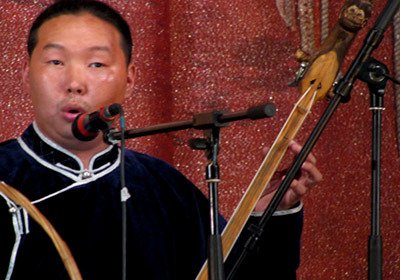
This video requires Flash version 7 or higher.
Click here to update your Flash player.
Tuvan throatsinging has five basic styles: the deep rumbling growl of kargyraa, the basic two tones of khoomei, the pure whistle of sygyt, the ripples of borbangnadyr, and the steady gait of ezengileer. All five styles are on display in this performance by Bady-Dorzhu Ondar, who accompanies himself on the two-stringed igil. I really grew to appreciate solo igil / throatsinging performances—when everything's working right, the voice and instrument blend to the point where it's hard to tell which sounds are coming from which.


Five days a week during my three months studying the South Indian Carnatic tradition in Chennai, I got on my bicycle and wove through traffic of every conceivable form to get to my music lessons. Along my route, I would pass a billboard that helpfully advised passers-by, "Go placidly amidst the noise and haste." As I tried not to inhale too much exhaust and watched out for motorbikes zooming up from behind, I attempted to live that motto.
Learning Carnatic music fit right into that effort. I had hours of lessons every day and spent even more time practicing. I could often find myself sitting for half an hour or more trying to sing a single scale. Which is, when you get right down to it, a pretty good way to stay placid in the chaos that is a major Indian metropolis.
On Sundays, I reversed roles and taught a class of children at the school where I was taking lessons. The instructors thought it would be interesting for the children to be exposed to Western harmony, and I dove in by teaching a few short, simple two and three part songs and warm-up exercises. It was a rewarding and highly educational experience-these kids could run circles around me in rhythm, holding multiple sets of rhythmic patterns in their heads at once. However, I had to start with absolute basics to get them to hear and sing harmonies.
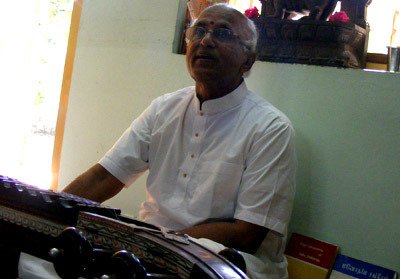
This video requires Flash version 7 or higher.
Click here to update your Flash player.
Carnatic performance is based on exploring the bounds of a certain raga (a scale, with a full set of characteristic patterns and stressed notes) and tala (one of the many meters that outline the rhythm of the piece). The technical challenge comes in building structures of notes that stray further and further away from one's starting point, while remaining within the rules of the raga and tala. For me, listening to Carnatic music is like riding a wave-there's always a point where I lose my conceptual grasp of what the singer is doing and just fall into the sound and let it wash over me until it arrives back on solid ground. This is a brief excerpt I recorded of my teacher, Karaikudi Subramanian.


South Africa was perhaps the hardest country for me to adjust to, largely because it always seemed like (at least) two completely different countries in one. I spent part of my time in conditions as undeveloped as I saw all year. In my host Vusi's village or in the small village in the Eastern Cape where I studied traditional Xhosa songs, there was no indoor plumbing, no paved roads, no hot water, sometimes no running water at all. However, in perhaps an hour's drive, I could be in surroundings that could have been lifted from suburban USA. During several weeks in Durban, I played pool in a backpackers' hostel, bought groceries in a well-stocked grocery store, and spent pleasant afternoons browsing through the library of the University of KwaZulu Natal.
I wanted to understand how these worlds existed side by side-at least when it came to music. There was a lot to soak in. Various elements of traditional genres, Western imports, and new ideas mixed to form the music that is performed today. I tried to experience all of those ingredients. In bits and pieces, spending a week in one place then moving on to another, I met with groups that perform very traditional Zulu and Xhosa music, choirs that perform isicathamiya-the powerful men's a cappella music created by Zulu mine workers at the turn of the 20th century-and a few choirs that sing contemporary Zulu gospel music.
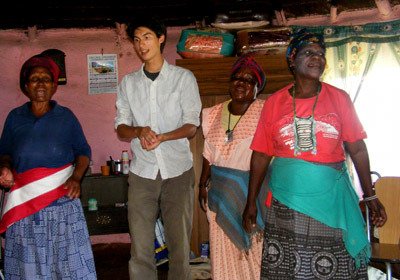
This video requires Flash version 7 or higher.
Click here to update your Flash player.
Both the Zulu and Xhosa traditions I heard in South Africa are participatory forms of music. In most cases, there is no audience-everyone contributes to the music and everyone appreciates it.
I really got a feeling for how this works during my time with the Ngqoko Cultural Group, a group of grandmothers deep in the Eastern Cape who preserve old Xhosa songs and styles of singing. Their songs are all based on very short cycles, which got very complex as they layered part after part on top of the lead and the footwork.
In this recording of the Ngqoko group, you'll also hear an example of umnqokolo singing (the low growl that sounds somewhat reminiscent of Tuvan kargyraa)


I arrived in Berlin at the end of May for the world beatbox championships. This tournament featured nearly a hundred of the best human beatboxers from around the world. The biggest (and strangest) names in the world were there-Markooz from Spain, Skiller from Bulgaria, Reeps1 and Bellatrix from the U.K., L.O.S. and Micspawn from France all battling the eventual champion ZeDe from Switzerland. I was in mouth music heaven. Magic happened on stage, and jam session after jam session popped up anywhere quiet enough for participants to hear one another.
The event captured what beatbox is about-pushing your own envelope and creating something that nobody has ever heard before. That's why beatboxers compete, and why they're always happy to explain their sounds to someone who's interested in learning. However, it's still a communal music. When good beatboxers jam, they're listening to the music that's being made and figuring out how to identify and fill in gaps.
Beatbox has, perhaps surprisingly, a stronger following in Europe than in the US. While Europe borrowed beatbox from American hip-hop, Euro beatbox has benefited from being able to blaze its own trail. What they have now is a community that embraces a full spectrum of beatboxers. There are guys who grew up in hip-hop and came to beatbox through breakdance and graffiti. There are dorky kids who saw a Rahzel video on YouTube and got hooked. There are musical geniuses who spent years making sounds with their mouths before they were told that they were beatboxing. As a mediocre beatboxer traveling the world learning mouth music, I fit right in and was welcomed by the community.

Making music with friends during a beatbox a cappella jam.


I arrived in Budapest just in time for a weeklong festival of gypsy music in all its forms. I quickly learned the difference between Romungro music (the flashy, violin driven tunes most of us hear when we think of gypsy music) and Vlach music (the traditional tunes played by amateur gypsy musicians for other gypsies). More difficult was developing an ear for the stylistic differences between Hungarian, Romanian, Serbian, and Czech traditions.
For nearly two weeks, I struggled to find a teacher. I was hampered by the worst language barrier I experienced all year-while many Hungarians speak English, very few Roma (and even fewer traditional Roma musicians) are in that number. I was thus blessed to finally meet Gusztav Balogh, a fantastic guitar player, singer, percussionist, and naturally gifted teacher. Gusztav could break down the essence of Roma music into terms I could grasp, then identify the technical skills I needed to translate that essence into sound.
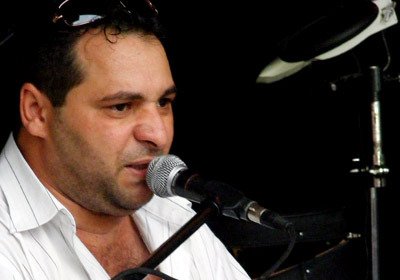
This video requires Flash version 7 or higher.
Click here to update your Flash player.
In Budapest, I studied the percussion that accompanies Vlach Roma dance music. The Vlach are the bulk of the Hungarian gypsy population, whose traditional occupations were as craftsmen and traders. Unlike professional Romungro gypsy musicians who entertained upper class Hungarian society, the Vlach traditionally perform with very few instruments. To provide rhythm, they use a combination of clacking spoons, banging on a metal water can, and a vocal percussion style called szajbögö (literally, 'oral bass'). Doing smooth, consistent szajbögö while accompanying yourself on the water can is a truly difficult art. But when done well, it's what gets people up and dancing. This is a short clip of one of my lessons with Guszti. He offers a phrase of szajbögö, and I attempt to repeat it).



I learned that creating beauty from noise is universal. And for me, learning how other people do that was the experience of a lifetime.
When I set out on my adventure the purpose of my travels was simply to learn to sing in new and interesting ways. Along the way I came to consider each stop a success only once I learned to listen with my newfound perspective and could value a performance based on local aesthetics. And in the end, I see that the lessons I learned were only partly about music. There were rules that governed music and rules that governed life. But at every step, I had to put aside my own notions of what made sense. I learned to figure out how what I was seeing or hearing could fit together into a coherent whole. I learned that creating beauty from noise is universal. And for me, learning how other people do that was the experience of a lifetime.


